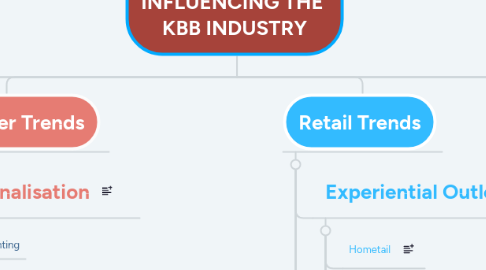
1. Social Trends
1.1. Changing Cooking Habits
1.1.1. 'Dark' Kitchens
1.1.2. Flexitarianism
1.1.3. Meal-Kit Subscriptions
1.1.4. Combating Food Waste
1.1.5. Buying Fresh & Local
1.1.6. Carbon-Neutral Cooking
1.1.7. Single Serve
1.1.8. Complicated Dietary Requirements
1.2. Pet Parents
1.2.1. Pet-friendly homes
1.2.2. Staycations
1.3. Working from home
1.3.1. Hybrid Housing
1.3.2. Co-Working spaces
1.4. Single Person Households
1.4.1. Co-Living Spaces
1.4.2. Pet Parents
1.5. Multi-Generational Households
1.5.1. Agelessness
1.5.2. The 'Sandwich' Generation
1.5.3. Boomerang Children
1.5.4. Hardworking Products
1.5.5. Home Accoustics
2. Demographic Trends
2.1. Ageing Population
2.1.1. Agelessness
2.1.2. Multi-Generational Households
2.1.3. Home Robotics
2.1.4. Smart Appliances
2.2. Falling Birth Rate/Smaller Family Sizes
2.2.1. Compact Living
2.3. Older Parents
2.3.1. Pet Parents
2.3.2. Health Awareness
3. Retail Trends
3.1. Experiential Outlets
3.1.1. Hometail
3.1.2. Un-Stores
3.1.3. Virtual Reality
3.1.4. Augmented Reality
3.1.5. Advising/demonstrating/educating
3.2. Me-Tailing
3.2.1. Artificial Intelligence (AI)
3.2.2. Gamification
3.2.3. Desire for Privacy
3.3. Seamless Omnichannel
3.3.1. RFID Tags
3.3.2. Click and Collect
3.4. Online Influencers
3.4.1. Instagrammable
3.5. Pop-Up Stores
4. Environmental Trends
4.1. Rethinking Waste
4.1.1. War on Plastic
4.1.2. Food Waste Technology
4.1.3. Smart Recycling
4.1.4. Water Security
4.2. Eco-Anxiety
4.2.1. Flexitarianism
4.2.2. Eco-Shaming
4.2.3. Political Spending
4.3. Circular Economy
4.3.1. Cradle to Cradle Design
4.3.2. Carbon Neutral Kitchens
4.4. Air Quality Concerns
4.4.1. Purified Air Technology
4.5. Home Acoustics
4.5.1. The Quiet Mark for Appliances
5. Consumer Trends
5.1. Personalisation
5.1.1. 3d Printing
5.1.2. Mass Customisation
5.1.3. Supporting Specialist Artisan Producers
5.1.4. Desire for Privacy
5.1.5. Me-Tailing
5.2. Wellness in the Home
5.2.1. Air Quality Concerns
5.2.2. Home Acoustics
5.2.3. Neuroaesthetics
5.2.4. Decluttering
5.3. Buying Time
5.3.1. Do-it-for-me
5.3.1.1. Meal-Kit Subscriptions
5.3.2. Time Saving Technology
5.4. Health Awareness
5.4.1. Self-Quantification
5.4.1.1. Toilet analytics
5.4.1.2. Smart Mirrors
5.5. Experiences above Products
5.5.1. Premiumisation
5.5.2. Face to Face Communication
5.5.3. Nomad Living
5.5.4. 'Slow' Living
5.5.5. JOMO
5.5.6. Simplicity and Minimalism
5.6. Political Spending
6. Economic Trends
6.1. The Sharing Economy
6.1.1. Dark Kitchens
6.1.2. Co-Working Spaces
6.1.3. Consumer to Consumer
6.2. Generation Rent
6.2.1. Co-Living Spaces
6.2.2. Renting Appliances
6.2.3. Nomad Living
6.2.4. Build-to-Rent
6.3. Urbanisation
6.3.1. Compact Living
6.3.2. Hardworking Products
6.3.3. Hybrid Housing
6.3.4. Robotic Furniture
7. Technology Trends
7.1. Home Robotics
7.1.1. Robotic Furniture
7.2. 3d-Printing
7.3. Voice-Activation
7.4. Surfaces as Screens
7.4.1. Smart Mirrors
7.4.2. Smart Worktops
7.5. Anxiety Tech
7.5.1. Toilet analytics
7.5.2. DNA Food Testing
7.6. Smart Appliances
7.6.1. Time Saving Technology
